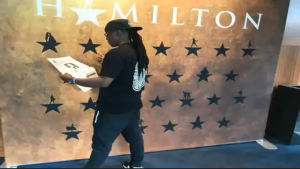Good Friday Agreement & AEH: An Analysis in Biden's UK & Ireland Visit and its Relevance to Solitary Confinement Reforms
The Good Friday Agreement of 1998 and the California Prisoner Racial Groups Agreement to End Hostilities of 2012 are examples of successful conflict resolution.
SILICON VALLEY, CALIFORNIA, UNITED STATES, April 8, 2023/EINPresswire.com/ -- On April 11-12, 2023, US President Joe Biden will travel to the UK and Ireland to mark the 25th anniversary of the Good Friday accord. The Good Friday Agreement (GFA), was signed a quarter century ago, as a US brokered agreement to help end decades of deadly sectarian violence in Northern Ireland.Last year, in 2012, marked the 10 year anniversary of the Agreement to End Hostilities (AEH). The AEH was an agreement amongst California prisoners being housed in the most extreme form of long-term solitary confinement, Pelican Bay State Prison's Short Corridor.
The AEH was an agreement between the various ethnic groups in the Short Corridor to end racial violence amongst California's General population housed prisoners, and non protective custody prisoners in security housing units (SHU), also known as solitary confinement. It was fashioned after, and inspired by, the Good Friday Agreement. The California prisoners agreement also extended to the county jails as well.
May 15, 2016, the Los Angeles Review of Books published writer and producer Alessando Camon's essay, "The Short Corridor: How the Most Isolated Prisoners in America Took on the System, and Won."
The essay gives the background and storyline of the peculiar form of long-term solitary confinement, known as the Short Corridor. Here are some excerpts:
"California is, notoriously, a hotbed of prison gangs, with some of the oldest and strongest in the entire US system tracing their roots to San Quentin, Soledad, or to the state’s Youth Authority facilities in the 1950s and ’60s. For the California Department of Corrections and Rehabilitation (CDCR), the solution to this problem was to be found in tougher security measures, according to the national trend that led to the rise of “supermax” prisons. This led to the creation of Pelican Bay in 1989. Designed to house about 2,700 inmates, including a thousand in its so-called Secure Housing Unit, Pelican Bay had it all: remote location, size, state-of-the-art security, the ironically quaint name. Despite Pelican Bay, gangs remained strong — even in Pelican Bay itself.
In 2006, a more proactive approach was introduced. Standard practice at the time was to split SHU prisoners according to their ethnic/geographic background. There are four recognized main groups in the California system: Southern Hispanics, Northern Hispanics, Whites, and Blacks. Anyone else is commonly referred to as “Others.” The Mexican Mafia, Nuestra Familia, Aryan Brotherhood, and Black Guerrilla Family are the historical gangs that draw from these constituencies. They have limited membership but extensive influence, with entry-level organizations doing their bidding and functioning as feeder systems. (Those organizations include Sureños, Norteños, Nazi Low Riders, and street-based gangs such as the Crips and Bloods.)
The policy of housing prisoners in homogeneous groups made intuitive sense, as the simplest way to reduce potential conflict between opposing gangs. However, it also seemed to allow gang members to share information, make collective decisions, and transmit orders to the prison mainline and the outside world. Gang leaders, or “shot-callers,” had a variety of methods for doing so, including invisible ink, hand signals, coded messages, “kites” (handwritten notes passed from cell to cell with makeshift fishing lines), and ingenious mail subterfuges (such as setting up fake law firms to send and receive letters that could not be inspected). A “green light” (death sentence) might be relayed on a scrap of paper pressed to the glass in the visiting booth. From the perspective of Gang Investigators, this posed a daunting challenge. How do you stop men so resourceful and committed, who may already be serving life without parole?
The new approach was to isolate a number of presumed shot-callers and “troublemakers” from the rest of their groups, clustering them together in a section of the SHU known as the Short Corridor (which isn’t actually short, but shorter than the others, with four housing units instead of six). The idea was that this would disrupt the gangs’ chains of command and communication. Prisoners assigned to the Short Corridor suddenly found themselves not only being held in solitary, but having unfamiliar, unwanted, potentially hostile neighbors.
In the prison system, this kind of social engineering has a long tradition. Pelican Bay’s very location, at California’s Northern border with Oregon, was chosen to enable the CDCR to move Southern California-based prisoners as far as possible away from their roots and areas of influence. The SHU itself was intended as a gang management tool: prisoners were sent to it not necessarily because of specific criminal actions, but on the assumption that they were active gang members. To earn release back to the general population, they were required to “debrief” (what prisoners call “snitching”)."
ASHKER V. GOVERNOR OF CALIFORNIA
According to the Center for Constitutional Rights, "Ashker v. Governor of California is a federal class action lawsuit on behalf of prisoners held in the Security Housing Unit (SHU) at California’s Pelican Bay State Prison who have spent a decade or more in solitary confinement. The case charges that prolonged solitary confinement violates the Eighth Amendment’s prohibition against cruel and unusual punishment, and that the absence of meaningful review for SHU placement violates the prisoners’ rights to due process. The legal action is part of a larger movement to reform conditions in SHUs in California's prisons that was sparked by hunger strikes by thousands of SHU prisoners in 2011 and 2013."
2012, saw the release of, "My 10 Year Prison Journey After the Agreement to End All Hostilities," an informative look at the California prison system post the AEH. Its author was also amongst the 33,000 prisoners who participated in the 2013, California prisoner hunger strike. The largest prisoner hunger strike in US history.
The author was featured in the June 22, 2021, edition of the Inter Press Service News Agency article "10th Anniversary of Prisoner Hunger Strike: Where Organizers Are Now," which included longtime artivist, MinisterKingXPyeface.
Since being released from prison in 2019, MinisterKingXPyeface has been on the forefront of getting the principal thinkers, the signatories to the AEH released from prison, through his Liberate the Elders campaign.
Another longtime prison abolitionist, Angela Y. Davis has been working with MinisterKingXPyeface to realize the impossible. In 2021, Visualizing Abolition, was awarded a $1.977 million grant by the Andrew W. Mellon Foundation, a New York-based nonprofit that supports the arts and humanities. Davis is now Distinguished Professor Emerita in the History of Consciousness and Feminist Studies Departments at the University of California, Santa Cruz.
The Visualizing Abolition initiative was founded in 2019 by Rachel Nelson, director of the Institute of Arts and Sciences, and Gina Dent, an associate professor of feminist studies at UCSC.
Arts-in-Correction has been a crucial component to rehabilitation development post AEH notes, California prison artist C-Note, the world's most prolific prison-artist.
"This new mindset allowed me and other prisoners to cross racial and gang ties to become actors for the play, 'Redemption in Our State of Blues.' This led to the first-in-the-nation reentry project called 'BREAK IT TO MAKE IT (BITMI): Busting Barriers for the Incarcerated Project, Los Angeles, California.'"
In 2005, MinisterKingXPyeface and C-Note met in solitary confinement, where MinisterKingXPyeface introduced C-Note to his inside organization KAGE Brothers (Kings and Queens Against Genocidal Environments). KAGE Brothers, now KAGE Universal, is a part of conflict resolution curriculum inside inner city schools.
Both men were featured in the 2021 film short Abolish It. The film short was a part of the 2021 online art exhibition Art on Abolition.
Art on Abolition was an online art exhibition, Sept 1 - Dec 31 2021. It was curated by Freedom and Captivity. Freedom and Captivity is a United States grassroots organization based in the State of Maine. The exhibition had three artistic goals, "What does abolition look like, sound like, feel like?" Art on Abolition included works responding to this prompt juried from a national open call. It featured over 70-works from over 40-artists. The exhibition was organized thematically:
History and New Futures
Protest and Revolution
Finding Voice, Power, Joy
Liberation
C-Note had two works in the exhibition, and both were in the Liberation theme. One was the Paintoem (painting+ poem), "The Prism of Abolitionism," while the other was the 10:00 min. movie short "Abolish It." The Prison of Abolitionism's opening stanza begins with an homage to the work of Angela Y. Davis, and her role in the abolitionist movement.
The Prison of Abolitionism (opening excerpt)
To be handed
Angela Davis's prism
on abolitionism
is a clear vision
"Abolish It" stars C-Note and MinisterKingXPyeface, with the soundtrack being produced by MinisterKingXPyeface and featuring his sister Abrique Brown on vocals. The movie chronicles how C-Note and MinisterKingXPyeface first meet in prison, and how Art has played a role in their shared journey. While C-Note is still locked up, MinisterKingXPyeface is free, and is pursuing their dream of going from the Kage to the Stage.
"My 10 Year Prison Journey After the Agreement to End All Hostilities," is a must read, as it is a history of the sounds, smells, fears, and hopes of racial conflicts and conflict resolutions from 2012 - 2022 inside the California Department of Corrections & Rehabilitations after the October 10th, 2012, implementation of the prisoner-led Agreement to End Hostilities (AEH)
To learn more about the AEH, and its positive impact on prison life, be sure to check out C-Note's essay, "My 10 Year Prison Journey After the Agreement to End All Hostilities," or the audio version on Spotify Podcast, and be sure to check out the 10:00 min. film short, "Abolish It," on YouTube.
My 10 Year Prison Journey After the Agreement to End All Hostilities | C-Note
https://www.c-note.org/my-10-year-prison-journey-after-the-agreement-to-end-all-hostilities/
My 10 Year Prison Journey After the Agreement to End All Hostilities | Spotify Podcast
https://podcasters.spotify.com/pod/show/cnote1/episodes/My-10-Year-Prison-Journey-After-the-Agreement-to-End-All-Hostilities-e1p484k/a-a8m12df
Abolish It | YouTube
https://youtu.be/7o6nbN5nBAA
ABOUT ANNA D. SMITH FINE ART AND REAL ESTATE BROKER:
Anna D. Smith Fine Art and Real Estate Broker in Silicon Valley, whose motto is "Fine Art needs a Home and a Home needs Fine Art ™," is a leading art advisory and brokerage firm, specializing in contemporary Underground art. In addition to its art services, the firm also provides real estate services related to buying and selling commercial or residential properties in Silicon Valley. With a reputation as the "Queen of the Underground Art World," founder Anna D. Smith has built Anna D. Smith Fine Art and Real Estate Broker into an art and real estate brokerage firm known for its expertise, professionalism, and commitment to client satisfaction.
Anna D. Smith
Anna D. Smith Fine Art and Real Estate Broker
4083910445 ext.
email us here
Visit us on social media:
Twitter
LinkedIn
Instagram
YouTube
Other
Abolish It





